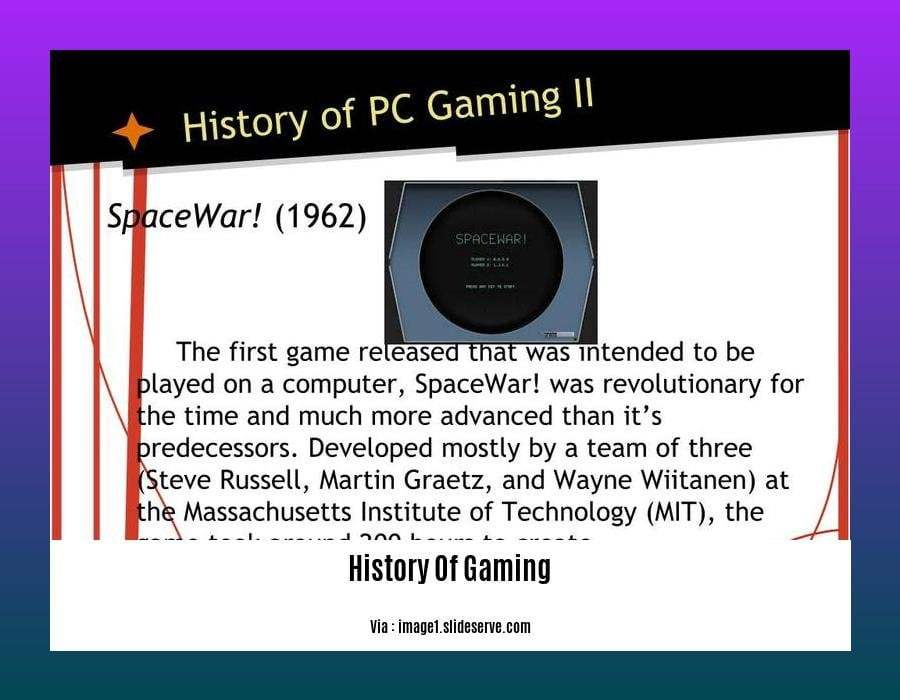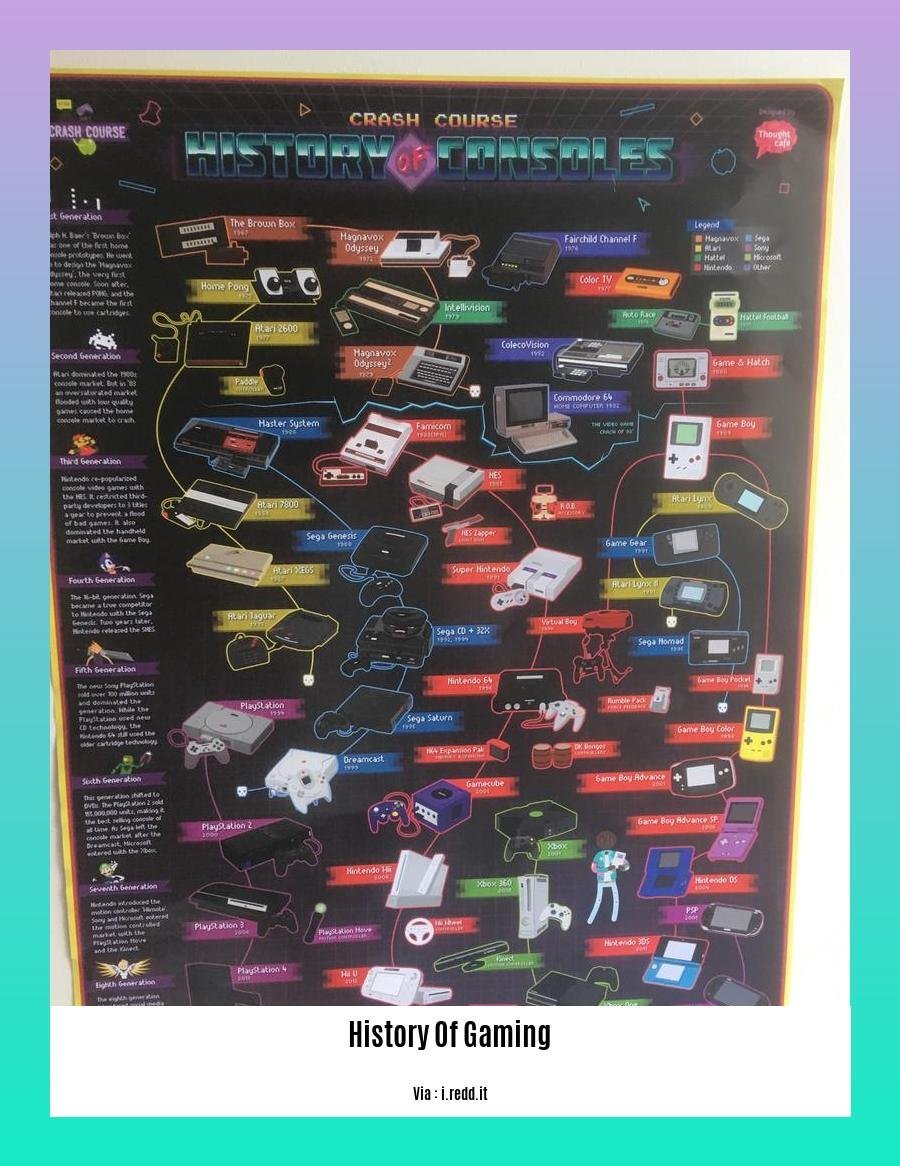Embark on a captivating journey through the annals of gaming in “A Comprehensive History of Gaming: From Pixels to Virtual Worlds.” This definitive guide traces the evolution of the industry from its humble beginnings to the cutting-edge advancements of today, exploring the pioneers, innovations, and cultural impact that have shaped the gaming landscape.
Key Takeaways:
- In 1952, Ralph Baer developed a prototype of the first multiplayer video game system.
- The North American gaming industry crashed in 1983 due to oversaturation.
- Sega released the Genesis console in 1989 as the successor to the Master System.
- The Xbox 360, PlayStation 3, and Wii ushered in the era of high-definition gaming in 2005-2006.
History of Gaming


Hey there, gaming enthusiasts! Let’s embark on an epic journey through the history of gaming, unearthing the pivotal moments that have shaped this vibrant digital realm.
Genesis: The Early Sparks
The seeds of gaming were sown in the mid-20th century when visionaries like Ralph Baer laid the foundation for interactive entertainment. Baer’s prototype, developed in 1952, paved the way for multiplayer gaming and multi-program systems.
Arcade Brilliance: The Golden Age
The 1970s witnessed the golden age of arcade games. Classics like “Pong” and “Pac-Man” captivated players with their addictive gameplay and vibrant pixels. Arcades became social hubs where gamers honed their skills and forged friendships.
Home Consoles: A Revolution Unfolds
The advent of home consoles in the 1980s revolutionized gaming. Systems like the Atari 2600 and Nintendo Entertainment System brought the arcade experience into living rooms. The history of gaming took a dramatic turn as iconic titles like “Super Mario Bros.” and “The Legend of Zelda” became household names.
Industry Crash and Rebirth
The industry faced a setback in 1983 due to market saturation and competition. However, the resilience of gaming was evident as it bounced back stronger than ever. The launch of the Nintendo Entertainment System in 1985 sparked a revival and ushered in a new era of innovation.
Sega vs. Nintendo: Console Wars Ignite
The 1990s witnessed intense rivalry between Sega and Nintendo. The Sega Genesis challenged the dominance of the Super Nintendo, with iconic titles like “Sonic the Hedgehog” captivating gamers. The console wars ignited a fierce competition that pushed the boundaries of gaming graphics and gameplay.
High-Definition Revolution
The early 21st century marked the advent of high-definition gaming. The Xbox 360, PlayStation 3, and Wii revolutionized the visual experience, ushering in an era of stunning graphics and immersive gameplay. Online multiplayer gaming became a norm, connecting players from around the globe.
Mobile Gaming: The Ubiquitous Revolution
The rise of smartphones and tablets brought gaming to an entirely new level. Mobile games like “Angry Birds” and “Candy Crush Saga” became global phenomena, capturing the attention of casual and hardcore gamers alike. The convenience and accessibility of mobile gaming expanded the gaming audience exponentially.
Virtual Reality and Beyond
The future of gaming lies in virtual reality and augmented reality. These technologies promise to transport players into immersive and interactive experiences like never before. The history of gaming continues to unfold, with new frontiers being explored and the boundaries of gaming constantly being pushed.
Dive into the evolution of gaming consoles that have shaped the gaming landscape, from primitive beginnings to cutting-edge advancements. Explore the profound impact of gaming on society, examining its influence on culture, education, and social behavior. Journey through the early video games that laid the foundation for the thriving industry we know today.
History of Gaming Wikipedia
The History of Gaming Wikipedia traces the evolution of video games from their humble beginnings in the mid-20th century to the immersive virtual worlds we experience today. Let’s dive into the key milestones that shaped this dynamic industry:
Genesis of Gaming
The roots of video games can be traced back to the 1950s and 1960s, when early computer scientists developed simple games on minicomputers and mainframes. Games like Bertie the Brain (1950) and Nimrod (1951) laid the foundation for the interactive entertainment we know today.
Rise of Arcade Culture
In the 1970s, arcade games took the world by storm. Classics like Pong (1972) and Breakout (1976) introduced competitive and social elements to gaming, attracting a wide audience to this new form of entertainment.
Home Console Revolution
The 1980s witnessed the rise of home video game consoles, led by industry giants Nintendo and Sega. Consoles like the Nintendo Entertainment System (NES) and Sega Genesis brought arcade-like experiences into living rooms, revolutionizing the gaming landscape.
Transition to 3D Graphics
The 1990s marked a turning point in gaming with the transition from raster graphics to 3D graphics. Games like Super Mario 64 (1996) and The Legend of Zelda: Ocarina of Time (1998) showcased the potential of three-dimensional worlds and immersive storytelling.
Technological Advancements
The 2000s and 2010s brought significant technological advancements in gaming. The introduction of high-definition graphics, online multiplayer experiences, and portable gaming systems expanded the reach and accessibility of video games.
The Present and Future
In the 2020s, ray-tracing and photorealistic graphics have emerged as key technologies, blurring the lines between virtual and real worlds. The future of gaming holds endless possibilities, with advancements in artificial intelligence, virtual reality, and the metaverse promising to redefine our gaming experiences.
Key Takeaways:
- The history of gaming spans over seven decades, from simple text-based games to the immersive worlds we enjoy today.
- The arcade era introduced competitive and social aspects to gaming, attracting a wider audience.
- The rise of home consoles made gaming accessible to a broader population.
- 3D graphics transformed gaming, creating immersive and realistic experiences.
- Technological advancements continue to reshape gaming, with new technologies like ray-tracing and virtual reality shaping the future of the industry.
Most Relevant URL Source:
History of Video Games – Wikipedia
FAQ
1. When did the era of high-definition gaming begin?
2. Who developed the first multiplayer, multi-program video game system?
3. What caused the North American gaming industry crash in 1983?
4. When was the Sega Genesis console introduced?
5. In whichdecade did computer scientists used electronic machines to create game systems?
- Amazing March Fun Facts: Unveiling History & Celebrations - April 15, 2025
- Master how to write height: A complete guide - April 15, 2025
- How High Are Your Standards Test: Find Your Perfect Match Now - April 15, 2025
















